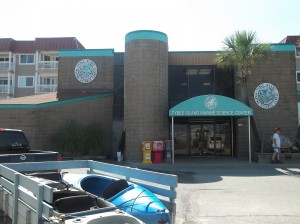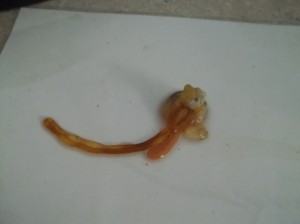WEEK 1:
Tybee Island has been both informative and full of excitement. My first week consisted of squid dissections, beach walks, sifting and seining classes, helping out the summer camps and learning hands on. At least once a day the summer camp heads out to the beach which is just steps from the Marine Science Center in pursuit of locating marine life both in and out of the water. My first day I was introduced to sifting and seining, a class where we are able to use large nets to catch palomino fish out of the white wash. These fish are an excellent example of the countershading many other marine animals use. I was also shown a few different loggerhead sea turtle’s nests along the dune line on the island.
Loggerheads are one of the 5 species of sea turtles that are in Georgia’s waters (There are only two species that do not visit us in Georgia). Loggerheads are the only species that lay their eggs on Tybee’s beaches and are heavily protected since they are endangered. All species of sea turtles are endangered, and their number one killer is human related causes. Whether the cause be entanglement, consumption of human debris or collisions with ships, unfortunately, only 1 out of 4,000 turtles make it to adulthood. The marine science center has a program called running start where they adopt a loggerhead in need every year to raise for a year. This year we have adopted “IKE” who was a straggler in his nest and never made it out and off into the ocean. Last august Ike was brought into the center and adopted as their turtle to go through the running start program. He is scheduled to be released in the next couple of months, when he is grown to be the width of a large dinner plate.
With fourth of July rolling around the beaches have been packed. Lots of people are swarming the beach which poses a threat to the hatching loggerheads. With increased numbers of people, there are also increased amounts of trash which the new hatchlings may get stuck in on their attempted journey to the ocean. It is the science center’s night/dawn patrolman who have to work extra hard to make sure the hatchlings are able to make it to the ocean safe.
On the beach walks we frequently see horseshoe crabs, blue crabs, spider crabs, cannonball jellyfish, and countless types of seashells that I am staring to be able to identify. With hurricane Arthur blowing past Tybee we are feeling the effects in or wave size. Usually, Tybee’s waves are relatively small and are only able to wash up tiny and broken sea shells. Wednesday, a red flag (hazardous) warning was put up because of the large waves and strong rip current and undertoe. Because the waves are much larger, huge sea shells have begun to was up on our beach. We are now finding much larger, more intact whelks and oysters which are normally very difficult to find. We were able to find a comb jelly and a sea cucumber. These were not normal finds so we brought them into the center. We were able to observe the comb jelly’s bioluminescence. As we would touch it, it would begin to give off a beautiful rainbow like glow which it uses as protection to either momentarily blind or distract the predator. The sea cucumber threw up its digestive tract, which is its normal defense to make themselves appear sick and unappetizing. The sea cucumber is able to generate a new digestive tract in a matter of a few days.
Digestive Tract:
All my mentors and educators have been extremely friendly, it’s like a little family at the marine science center. They are all willing to help me to continue to learn for the next couple of weeks and I am sure I will continue to learn and experience new things.
Jessie Jackman
Tybee Island Marine Science Center (Georgia)
Marine Biology



There are no comments published yet.